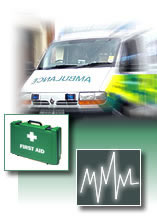| |
FRACTURES, SPRAINS & STRAINS
The signs suggesting possible fractures,
sprains or strains are swelling, discoloration, deformity and pain.
The person may not be able to use the part of the anatomy in question.
It is not possible, ascertain whether it is a fracture, sprain or
strain, so treat all as a fracture.
There are two types of fractures, open and closed. With an open fracture
the bone brakes through the skin and bleeding is present. At this
stage do not try to clean the wound or push the bone back under the
skin. Do not move the person in question. Keep them warm, still and
treat them for shock if necessary. Dial 999 for an ambulance.
Fractures
It is important to try and immobilise the affected limb. Boards,
cardboard, magazines, pillows and rolled up newspapers can make
very good splints.
ONE
Place the splint above and below the fracture so that the splint
extends beyond the fracture site.
TWO
Tie the splint to the fracture carefully, leaving the knot tied
on the splint. If the fracture is on the arm, put the arm in a sling.
Broken Back or Neck
The signs of a broken back include pain, numbness and or an inability to move
the legs or toes. In the case of a broken neck the person may experience
numbness around the shoulders, inability to move the fingers and complete
or partial paralysis of limbs. Perform necessary CPR if the person fall unconscious
or has difficulty breathing. The person must be completely immobilised. Never
move the person, unless they or you are in immediate danger. Keep the person
warm and still. Keep the person lying flat and hold the person’s head
in a straight, neutral position until the ambulance arrives.
Head Injuries
In the case of head injuries or skull fractures, the victim may bleed from
the mouth, nose or ears. They may be unconscious, vomiting, feeling very drowsy,
confused, suffering from loss of balance, have incoherent speech, ringing in
ears, nausea and have severe headaches. The person should lie down and keep
their head as still as possible, like with broken neck. If the person is bleeding
or vomiting from the mouth, they should be gently turned on to their side.
Ensure their head and neck are in line and their airway is open.
|
|


